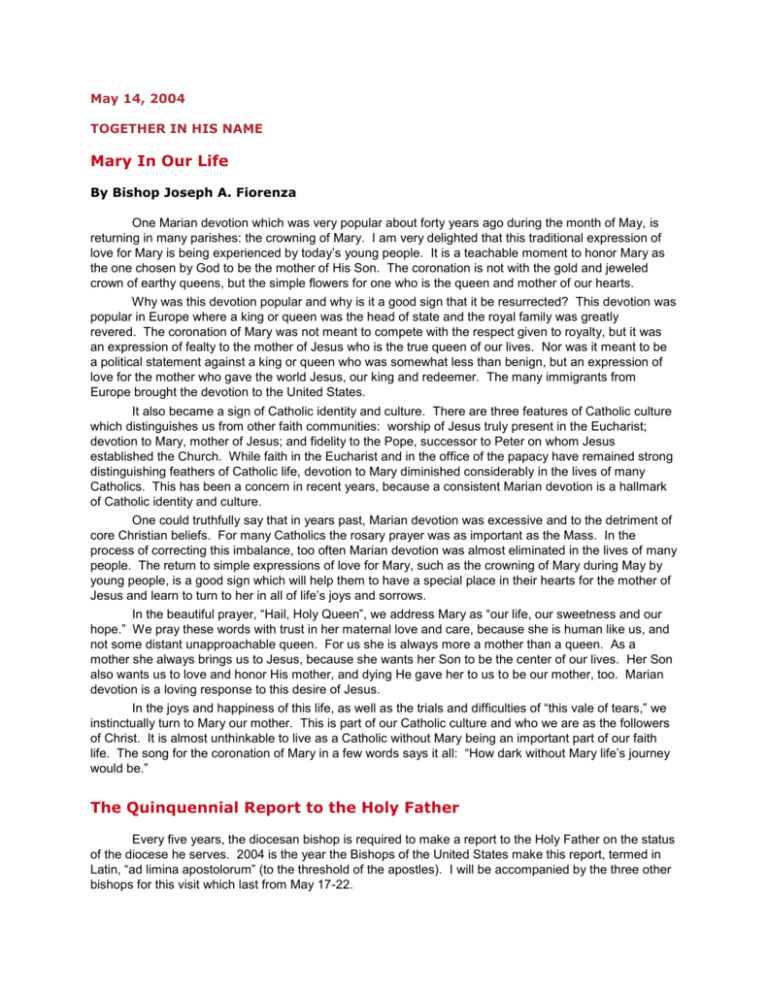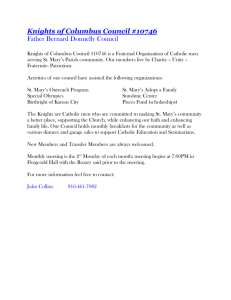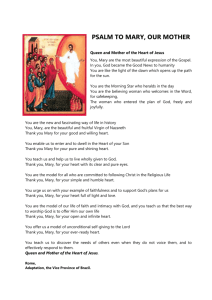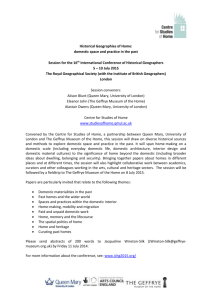Mary-In-Our-Life-5-14-2004 - Archdiocese of Galveston
advertisement

May 14, 2004 TOGETHER IN HIS NAME Mary In Our Life By Bishop Joseph A. Fiorenza One Marian devotion which was very popular about forty years ago during the month of May, is returning in many parishes: the crowning of Mary. I am very delighted that this traditional expression of love for Mary is being experienced by today’s young people. It is a teachable moment to honor Mary as the one chosen by God to be the mother of His Son. The coronation is not with the gold and jeweled crown of earthy queens, but the simple flowers for one who is the queen and mother of our hearts. Why was this devotion popular and why is it a good sign that it be resurrected? This devotion was popular in Europe where a king or queen was the head of state and the royal family was greatly revered. The coronation of Mary was not meant to compete with the respect given to royalty, but it was an expression of fealty to the mother of Jesus who is the true queen of our lives. Nor was it meant to be a political statement against a king or queen who was somewhat less than benign, but an expression of love for the mother who gave the world Jesus, our king and redeemer. The many immigrants from Europe brought the devotion to the United States. It also became a sign of Catholic identity and culture. There are three features of Catholic culture which distinguishes us from other faith communities: worship of Jesus truly present in the Eucharist; devotion to Mary, mother of Jesus; and fidelity to the Pope, successor to Peter on whom Jesus established the Church. While faith in the Eucharist and in the office of the papacy have remained strong distinguishing feathers of Catholic life, devotion to Mary diminished considerably in the lives of many Catholics. This has been a concern in recent years, because a consistent Marian devotion is a hallmark of Catholic identity and culture. One could truthfully say that in years past, Marian devotion was excessive and to the detriment of core Christian beliefs. For many Catholics the rosary prayer was as important as the Mass. In the process of correcting this imbalance, too often Marian devotion was almost eliminated in the lives of many people. The return to simple expressions of love for Mary, such as the crowning of Mary during May by young people, is a good sign which will help them to have a special place in their hearts for the mother of Jesus and learn to turn to her in all of life’s joys and sorrows. In the beautiful prayer, “Hail, Holy Queen”, we address Mary as “our life, our sweetness and our hope.” We pray these words with trust in her maternal love and care, because she is human like us, and not some distant unapproachable queen. For us she is always more a mother than a queen. As a mother she always brings us to Jesus, because she wants her Son to be the center of our lives. Her Son also wants us to love and honor His mother, and dying He gave her to us to be our mother, too. Marian devotion is a loving response to this desire of Jesus. In the joys and happiness of this life, as well as the trials and difficulties of “this vale of tears,” we instinctually turn to Mary our mother. This is part of our Catholic culture and who we are as the followers of Christ. It is almost unthinkable to live as a Catholic without Mary being an important part of our faith life. The song for the coronation of Mary in a few words says it all: “How dark without Mary life’s journey would be.” The Quinquennial Report to the Holy Father Every five years, the diocesan bishop is required to make a report to the Holy Father on the status of the diocese he serves. 2004 is the year the Bishops of the United States make this report, termed in Latin, “ad limina apostolorum” (to the threshold of the apostles). I will be accompanied by the three other bishops for this visit which last from May 17-22. A report on every aspect of diocesan life has been sent in advance of the visit so that the Holy Father and the officials of the Holy See can be advised of the report. The essence of the “ad limina visit” is to pray at the tombs of the apostles Peter and Paul and to visit with the Holy Father. We will meet with the Pope in a private audience and at the end of the week he will give a major address to all the Bishops from Texas, Oklahoma and Arkansas (region X of the U.S. Episcopal Conference). We will also meet with the officials of the major departments of the Holy See to discuss matters of mutual concern. The Bishops will celebrate the Eucharist together in St. Peter’s and at St. Paul outside the wall. These two experiences will be a reminder that we are the successors of the apostles and our responsibility to pass on and guard the integrity of the faith which we have received from the apostles. Due to the Pope’s age and physical condition we will not celebrate Mass with him or share a meal. These were special features of past “ad limina visits.” This will be my fifth quinquennial visit and my last one as a diocesan bishop. I will bring to the Holy Father the prayers of the people of the Diocese of Galveston-Houston and the assurance of our love and loyalty.









